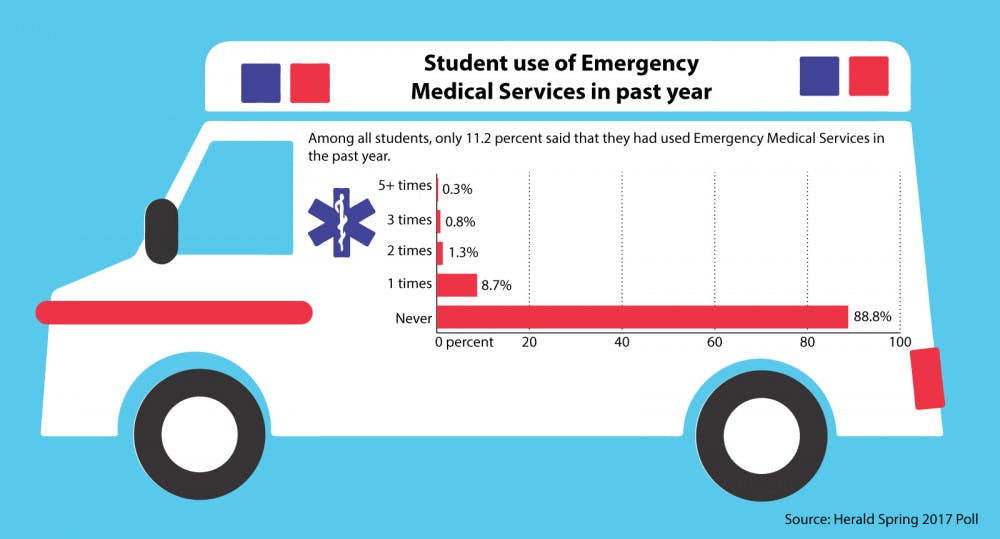Forty years after the founding of Brown Emergency Medical Services, the program is becoming increasingly student-run. The Basic Life Support supervising program, started five years ago, allows for student-led trainings and select medical emergencies to be addressed entirely by students.
Katie Luchette ’18 is one of three students on shift Tuesday morning. It’s 7 a.m., and she is sitting in a chair dressed in navy blue work pants and a dark EMS pull-over. She relaxes in the basement of the Health Services building, which houses the University’s EMS staff. It consists of a living room with a kitchenette, two bedrooms to house overnight students and staff and training areas.
Luchette will work from 7 a.m. to 1 p.m. Tuesday mornings and 1 p.m. to 7 p.m. Friday afternoons, which comprises a 12-hour work week. Emergency Medical Technicians are expected to work one six-hour shift per week, one 12-hour overnight or a weekend shift once every two weeks. But Luchette is not a standard EMT; she is a Basic Life Support supervisor. Luchette’s position as a BLS supervisor means that unlike EMTs, she went through additional training that qualifies her for more agency in her work, allowing her to treat more serious medical issues, drive the ambulance and train EMTs.
At 7:28 a.m., a call comes in. By 7:29 a.m., Luchette is out the side door, followed by one Emergency Medical Technician, one recruit and an Advanced Life Support supervisor. By 7:30 a.m, the ambulance’s siren is on and a small van is trailing the lights in the distance.
Luchette returns from driving the ambulance at 7:42 a.m. The patient had refused to go to the hospital. EMT Edward Chen ’19 and recruit Samuel Hornstein ’19 fill out a report form in the back.
“I really like that I am at a point where there is a lot of teaching going on,” said Luchette. “I am supervisor, so when I’m on call, I am able to allow recruits and EMTs to practice new skills that they might not be comfortable with.”
Luchette chose to join EMS after a trying first year at the University that left her feeling uninvolved and isolated, she said. Her decision has given her a lot more than just an extracurricular activity, she added.
“It sounds cheesy, but I’ve grown in a lot of ways as a person by working with (EMS) because it forces me to be more confident and be more assertive in ways that, outside of EMS, I don’t feel comfortable being,” Luchette said.
The BLS supervising position is part of a new initiative led by Brown EMS Chief Amy Sanderson to become a more student-centered organization. The service cannot be entirely student-run because the ambulance requires Advanced Life Support, Sanderson said. Advanced Life Support supervisors have attended six months of additional training and are certified to treat life-threatening medical emergencies such as cardiac arrest. After a student officer board formed in 2013 to allot more responsibility to student leaders, some calls were designated such that they can be staffed exclusively by students. A BLS supervisor drives the ambulance while an ALS supervisor takes “utility one” — a fly car that trails the ambulance. If the patient requires advanced life support, the BLS and ALS supervisors will switch positions.
“I’m the Wizard of Oz behind the curtain of EMS, but I’m not the heart,” Sanderson said, adding that this program would not be possible without active student leaders.
Luchette and her co-supervisors are also in charge of managing the 70 EMTs. Chen said he appreciates the student-to-student interactions that define his job.
“I also love being able to actually interact with people who need care,” Chen said. “It’s a great and humbling experience to be able to be in a position to help people.”
As an EMT, Chen has leadership responsibilities as well. Chen is responsible for teaching recruits how to work for EMS.
Hornstein, also on-call Tuesday morning, is a recruit. After taking an EMS class this summer at the University, he is now halfway through his semester of training. Hornstein was one of around 100 students who applied to become an EMT this year, Sanderson said. Approximately 30 students were accepted, as determined by an interview process that stressed the importance of “people skills” and the ability to communicate effectively, she added.
Trainings for recruits, EMTs and BLS supervisors occur during most shifts. On Tuesday, Hornstein reviewed administrating medicine.
“I think we are more confident providers than we used to be,” Sanderson said of the progression training model where students are responsible for teaching each other.
After the trainings are done and while EMS students wait to be called on, Luchette, Chen and Hornstein are able to go about their days. They go to Bagel Gourmet and get breakfast, then take off to class. But they sit in the back of their classrooms with their radios on, ready to respond if needed.





